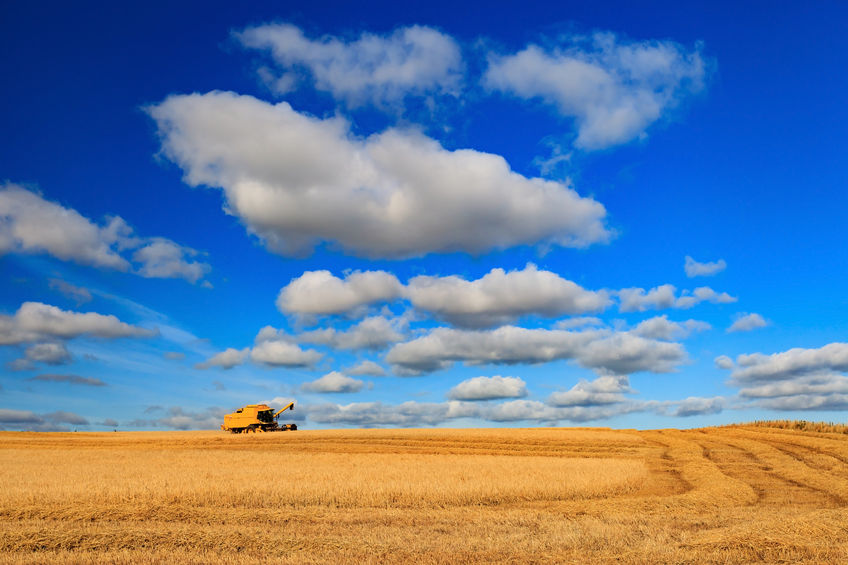
English wheat acreage is down by 2.5 per cent this year, according to provisional figures from the Department for Environment, Food and Rural Affairs (Defra).
Figures are contained in the first results from the 2017 June Survey of Agriculture and Horticulture.
Provisional estimates are included for the main cereal, oilseed and uncropped arable land areas on commercial holdings. Statistics show falls in acreage for wheat, winter barley and oilseed rape, but increases for spring barley and oats.
The survey estimates indicate that a total of 1.64 million hectares of land were planted with wheat - a fall of 2.5 per cent on 2016.
All of the English regions have seen a reduction in acreage, according to the survey, although some places have seen a larger fall than others.
In the North East acreage is down by just 0.3 per cent at 67,000 hectares. In the Eastern region the estimate is 454,000 - a fall of 2.9 per cent. In the East Midlands the fall is 3.7 per cent - down to 323,0000 hectares.
The Eastern region and the East Midlands grow almost half of the wheat in the country, accounting for 28 per cent and 20 per cent of the total area respectively.
Barley
The total area of barley has increased by six per cent year-on-year - up from 791,000 hectares in 2016 to 839,000 hectares in 2017.
Whilst winter barley has fallen by four per cent to 361,000 hectares in 2017 from 376,000 hectares last year, this is more than offset by a 15 per cent increase in the area sown with spring barley.
Acreage of spring barley is up year-on-year from 416,000 in 2016 to 478,000 hectares in 2017.
Spring sown barley now accounts for 57 per cent of the total barley area and winter sown barley has fallen back to 43 per cent.
The biggest regional falls in the acreage of winter barley are in the East Midlands (down 6.1 per cent), West Midlands (down six per cent) and South West (down 5.5 per cent). The biggest increase in spring barley is in the East Midlands.
The acreage is up by 21.2 per cent from 60,000 to 73,000 hectares. There are also big increases in the South East region (17.8 per cent), the Eastern region (15.4 per cent), Yorkshire and the Humber (13.7 per cent) and West Midlands (13.5 per cent).
Oilseed rape
The acreage of oilseed rape is down in England yet again. The 2017 estimate suggests that the area planted with oilseed rape is down 3.8 per cent from 543,000 hectares in 2016 to 522,000 hectares in 2017.
This is the fifth year running that the acreage of oilseed rape has fallen in England.
The Defra survey suggests that this year's reduction is largely due to a 3.8 per cent decrease in the winter sown area, which stands at 514,000 hectares and accounts for some 98 per cent of the total oilseed area. Spring sown oilseed rape is also down - falling by 4.3 per cent.
However, the 8,000 hectares accounts for only two per cent of the total oilseed rape area. This represents the second smallest area of spring oilseed planted for the last 20 years.
Regionally, the largest fall in OSR acreage is in the Eastern region, where the number of hectares is down from 130,000 hectares in 2016 to 116,000 hectares in 2017. This is a fall of 10.9 per cent. The Eastern region and the East Midlands account for the largest proportion of OSR produced in England.
They make up 48 per cent of the country's total oilseed area. The acreage in East Midlands is also down this year - from 139,000 hectares to 135,000 hectares. This is a fall of 3.4 per cent.
Most regions have seen a fall in OSR acreage, although there are exceptions. The area of oilseed in the North West and Merseyside is up by 4.8 per cent, although the number of hectares is only 5,000, and in the South West it is up by 1.6 per cent.
Oats
The number of hectares sown with oats in England is up by 17 per cent this year from 102,000 in 2016 to 120,000 in 2017. It is the second highest area of oats planted in the country in the last 30 years.
The biggest percentage rise is in the Eastern region, where acreage is up by 31.6 per cent from 12,000 to 16,000 hectares. There are increases of nearly 20 per cent in the North West and Merseyside, 18 per cent in the North East and West Midlands, 15.2 per cent in Yorkshire and the Humber, and 13 per cent in the East Midlands, South East and South West.
The provisional estimate of uncropped arable land in England is 193 thousand hectares. This is a decrease of 11 per cent since 2016 and equates to 24 thousand hectares less land being left out of production.
The Defra report says that some 70 per cent of the winter barley and 75 per cent of the winter oilseed rape crop had been harvested by August 3. It indicates that the winter oilseed rape harvest is ahead of the five year average.
The first official Defra harvest estimates for wheat and barley are expected in October.
